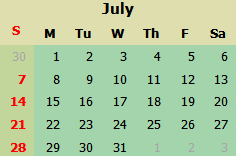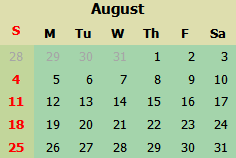Team:SCU China/Notebook
From 2013.igem.org
Zhangbingbio (Talk | contribs) |
Zhangbingbio (Talk | contribs) |
||
| (10 intermediate revisions not shown) | |||
| Line 23: | Line 23: | ||
| - | + | {|style="width:200px;background-color:transparent" border="0" cellspacing="0" align=center | |
| - | + | |[[file:SCU-Mar1.png|160x200px|link=https://2013.igem.org/SCU_Weekly#Weekly_Notes]] | |
| - | | | + | |[[file:SCU-Jun.png|160x200px|link=https://2013.igem.org/SCU_Weekly#June]] |
| - | + | ||
| - | |[[file:SCU- | + | |[[file:SCU-July.png|160x200px|link=https://2013.igem.org/SCU_Weekly#July]] |
| - | |[[file:SCU- | + | |[[file:SCU-Aug.png|160x200px|link=https://2013.igem.org/SCU_Weekly#August]] |
| - | |[[file:SCU- | + | |[[file:SCU-Sep1.png|160x200px|link=https://2013.igem.org/SCU_Weekly#September]] |
| - | + | ||
| - | + | ||
| - | + | ||
| - | + | ||
|} | |} | ||
| - | + | __NOEDITSECTION__ | |
| + | {|style="width: 806px" border="0" cellspacing="1" cellpadding="15px" align="center" | ||
| + | | | ||
---- | ---- | ||
=='''iGEM SCU experiment protocol'''== | =='''iGEM SCU experiment protocol'''== | ||
| - | + | __TOC__ | |
| - | '''Transformation''' | + | ==='''Transformation'''=== |
#Thaw the competent cells on ice for about 10-15 minutes. | #Thaw the competent cells on ice for about 10-15 minutes. | ||
| Line 59: | Line 56: | ||
| | ||
| - | '''Liquid culture to grow bacteria from a single colony''' | + | ==='''Liquid culture to grow bacteria from a single colony'''=== |
#Add 5 mL LB into each 10 mL or 15 mL tube. | #Add 5 mL LB into each 10 mL or 15 mL tube. | ||
| Line 69: | Line 66: | ||
| | ||
| - | '''3A Assembly''' | + | ==='''3A Assembly'''=== |
#Restriction Digests | #Restriction Digests | ||
| Line 85: | Line 82: | ||
| | ||
| - | '''Traditional assembly (standard assembly) methods''' | + | ==='''Traditional assembly (standard assembly) methods'''=== |
For Standard Assembly, a part sample is cut out from its plasmid backbone and inserted into the prefix of a plasmid backbone of another part (we use ''Eco''RⅠand ''Xba Ӏ ''to digest plasmid backbone and use ''Eco''RⅠand ''Spe''Ⅰto digest the target part). Two restriction digests are done, one for the part sample that will be moved and one for the plasmid backbone that will receive it. The digests are then run on a gel and using gel purification the required fragments are isolated (the part sample and the cut plasmid backbone). The purified insert and cut plasmid backbone are ligated and the resulting composite part can be transformed into ''E. coli ''cells. | For Standard Assembly, a part sample is cut out from its plasmid backbone and inserted into the prefix of a plasmid backbone of another part (we use ''Eco''RⅠand ''Xba Ӏ ''to digest plasmid backbone and use ''Eco''RⅠand ''Spe''Ⅰto digest the target part). Two restriction digests are done, one for the part sample that will be moved and one for the plasmid backbone that will receive it. The digests are then run on a gel and using gel purification the required fragments are isolated (the part sample and the cut plasmid backbone). The purified insert and cut plasmid backbone are ligated and the resulting composite part can be transformed into ''E. coli ''cells. | ||
| Line 91: | Line 88: | ||
| | ||
| - | '''Miniprep protocol''' | + | ==='''Miniprep protocol'''=== |
We use MINIPREP PLASMID KIT (TIANGEN BIOTECH, CHINA) for miniprep. | We use MINIPREP PLASMID KIT (TIANGEN BIOTECH, CHINA) for miniprep. | ||
| Line 97: | Line 94: | ||
| | ||
| - | '''Restriction digestion''' | + | ==='''Restriction digestion'''=== |
We conduct our experiments following the standard protocol from the HD, except for no adding BSA into our mixture. | We conduct our experiments following the standard protocol from the HD, except for no adding BSA into our mixture. | ||
| Line 103: | Line 100: | ||
| | ||
| - | '''Ligation''' | + | ==='''Ligation'''=== |
We follow the standard protocol from HD web to conduct our ligation experiments. | We follow the standard protocol from HD web to conduct our ligation experiments. | ||
| Line 109: | Line 106: | ||
| | ||
| - | '''Making linearized plasmid backbones''' | + | ==='''Making linearized plasmid backbones'''=== |
We do this by the bulk production protocol from HD. | We do this by the bulk production protocol from HD. | ||
| Line 115: | Line 112: | ||
| | ||
| - | '''Competent cells''' | + | ==='''Competent cells'''=== |
We choose DH5α from TIANGEN BIOTECH as our competent cells meterials. | We choose DH5α from TIANGEN BIOTECH as our competent cells meterials. | ||
| Line 121: | Line 118: | ||
| | ||
| - | '''Quantifying fluorescence of GFP expressed in ''E. coli''''' | + | ==='''Quantifying fluorescence of GFP expressed in ''E. coli'''''=== |
We choose plate reader to detect fluorescence of GFP expressed in ''E. coli.'' | We choose plate reader to detect fluorescence of GFP expressed in ''E. coli.'' | ||
| Line 131: | Line 128: | ||
| | ||
|} | |} | ||
| - | |||
| - | |||
| - | |||
| | ||
Latest revision as of 21:26, 27 September 2013


| 
| 
| 
| 
|
iGEM SCU experiment protocolTransformation
Liquid culture to grow bacteria from a single colony
3A Assembly
Traditional assembly (standard assembly) methodsFor Standard Assembly, a part sample is cut out from its plasmid backbone and inserted into the prefix of a plasmid backbone of another part (we use EcoRⅠand Xba Ӏ to digest plasmid backbone and use EcoRⅠand SpeⅠto digest the target part). Two restriction digests are done, one for the part sample that will be moved and one for the plasmid backbone that will receive it. The digests are then run on a gel and using gel purification the required fragments are isolated (the part sample and the cut plasmid backbone). The purified insert and cut plasmid backbone are ligated and the resulting composite part can be transformed into E. coli cells.
Miniprep protocolWe use MINIPREP PLASMID KIT (TIANGEN BIOTECH, CHINA) for miniprep.
Restriction digestionWe conduct our experiments following the standard protocol from the HD, except for no adding BSA into our mixture.
LigationWe follow the standard protocol from HD web to conduct our ligation experiments.
Making linearized plasmid backbonesWe do this by the bulk production protocol from HD.
Competent cellsWe choose DH5α from TIANGEN BIOTECH as our competent cells meterials.
Quantifying fluorescence of GFP expressed in E. coliWe choose plate reader to detect fluorescence of GFP expressed in E. coli. Before detecting the fluorescence on plate reader, we view the fluorescence of E. coli with a fluorescence microscope to make sure that GPF expresses normally in vivo. Incubate bacteria for certain periods of time, then take some sample out and add it into each well on 96 well plate (for our experiment, we add 150 μL per well).
|
 "
"